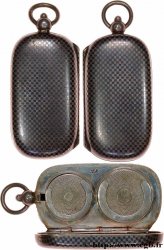Live auction - fme_968280 - TERZA REPUBBLICA FRANCESE Médaille commémorative de la bataille de Verdun
Devi Sign-in ed essere un offerente approvato fare un'offerta, Login per fare offerte. Conti sono soggetti ad approvazione e di approvazione sono raggiunti entro 48 ore. Non aspettare fino al giorno di una vendita si chiude per registrarti.Confermando la tua offerta su questo oggetto ti impegni ad un contratto legalmente vincolante per l'acquisto di questo prodotto e fare clic su «offerta» costituisce accettazione dei termini di utilizzo de live auctions cgb.fr.
Offerta deve essere collocato in euro gli importi interi vendita only.The si chiuderà al momento sulla descrizione dell'oggetto, eventuali offerte pervenute al sito dopo l'orario di chiusura non verranno eseguite. Volte transmition possono variare e le offerte potrebbero essere respinto se si attende per gli ultimi secondi. Per ulteriori informazioni ckeck le FAQ Live auction.
Le offerte vincenti saranno sottomesse ai 18% per spese di compartecipazione alla vendita.
Le offerte vincenti saranno sottomesse ai 18% per spese di compartecipazione alla vendita.
| Valutazione : | 10 € |
| Prezzo : | 9 € |
| Offerta maxima : | 9 € |
| Data di fine vendita : | 19 novembre 2024 15:34:46 |
| partecipanti : | 4 partecipanti |
Tipo : Médaille commémorative de la bataille de Verdun
Data: 1916
Nome della officina / città: 55 - Verdun
Metallo : bronzo
Diametro : 72 mm
Asse di coniazione : 12 h.
Incisore VERNIER Émile Séraphin (1852-1927)
Peso : 10,13 g.
Orlo : lisse
Marchio : corne BR
Commenti sullo stato di conservazione:
Patine hétérogène avec des tachs d’oxydation
Diritto
Titolatura diritto : ON NE PASSE - PAS .
Descrittivo diritto : Allégorie de la ville avec son épée; signé : VERNIER.
Rovescio
Titolatura rovescio : VERDUN // 21 FEVRIER / 1916.
Descrittivo rovescio : Portes de la ville entre deux palmes. Corne d’abondance BR à l’exergue.
Commento
Diamètre sans bélière : 27,5 mm.
Ruban rouge bordé de rayures bleu, blanc et rouge.
Émile Séraphin Vernier, né à Paris le 16 octobre 1852, décédé à Paris le 9 septembre 1927, est sculpteur, plaquettiste, ciseleur et graveur-médailleur français.
En août 1915, le Quartier Général français ne reconnaissant plus aucune valeur stratégique aux forts, désarme ceux autour de Verdun et supprime la garnison. L’État-major allemand profite alors de la vulnérabilité de la place, pour mener une offensive. Le 21 février 1916 vers 7 heures, deux millions d'obus s’abattent sur Verdun. Mais contrairement à ce à quoi s'attendaient les Allemands et leur commandant en chef le général Erich von Falkenhayn, l'armée française résiste et campe sur ses positions.
La bataille dure près de 10 mois, faisant 163 000 morts et 216 000 blessés du côté français et 143 000 morts et 196 000 blessés du côté allemand. À l'automne 1916, l'armée française, profitant de l'offensive de la Somme, contre-attaque, reprend les forts perdus et repousse les Allemands. Verdun est sauvée....
Diameter without bail: 27.5 mm. Red ribbon edged with blue, white, and red stripes. Émile Séraphin Vernier, born in Paris on October 16, 1852, died in Paris on September 9, 1927, was a French sculptor, plaquetist, chaser, and medal engraver. In August 1915, the French General Headquarters, no longer recognizing any strategic value in the forts, disarmed those around Verdun and removed the garrison. The German General Staff then took advantage of the vulnerability of the place to launch an offensive. On February 21, 1916, around 7 a.m., two million shells rained down on Verdun. But contrary to what the Germans and their commander-in-chief, General Erich von Falkenhayn, expected, the French army resisted and camped on its positions. The battle lasted nearly 10 months, leaving 163,000 dead and 216,000 wounded on the French side and 143,000 dead and 196,000 wounded on the German side. In the autumn of 1916, the French army, taking advantage of the Somme offensive, counterattacked, recaptured the lost forts, and drove back the Germans. Verdun was saved...
Ruban rouge bordé de rayures bleu, blanc et rouge.
Émile Séraphin Vernier, né à Paris le 16 octobre 1852, décédé à Paris le 9 septembre 1927, est sculpteur, plaquettiste, ciseleur et graveur-médailleur français.
En août 1915, le Quartier Général français ne reconnaissant plus aucune valeur stratégique aux forts, désarme ceux autour de Verdun et supprime la garnison. L’État-major allemand profite alors de la vulnérabilité de la place, pour mener une offensive. Le 21 février 1916 vers 7 heures, deux millions d'obus s’abattent sur Verdun. Mais contrairement à ce à quoi s'attendaient les Allemands et leur commandant en chef le général Erich von Falkenhayn, l'armée française résiste et campe sur ses positions.
La bataille dure près de 10 mois, faisant 163 000 morts et 216 000 blessés du côté français et 143 000 morts et 196 000 blessés du côté allemand. À l'automne 1916, l'armée française, profitant de l'offensive de la Somme, contre-attaque, reprend les forts perdus et repousse les Allemands. Verdun est sauvée....
Diameter without bail: 27.5 mm. Red ribbon edged with blue, white, and red stripes. Émile Séraphin Vernier, born in Paris on October 16, 1852, died in Paris on September 9, 1927, was a French sculptor, plaquetist, chaser, and medal engraver. In August 1915, the French General Headquarters, no longer recognizing any strategic value in the forts, disarmed those around Verdun and removed the garrison. The German General Staff then took advantage of the vulnerability of the place to launch an offensive. On February 21, 1916, around 7 a.m., two million shells rained down on Verdun. But contrary to what the Germans and their commander-in-chief, General Erich von Falkenhayn, expected, the French army resisted and camped on its positions. The battle lasted nearly 10 months, leaving 163,000 dead and 216,000 wounded on the French side and 143,000 dead and 196,000 wounded on the German side. In the autumn of 1916, the French army, taking advantage of the Somme offensive, counterattacked, recaptured the lost forts, and drove back the Germans. Verdun was saved...








 Segnalare un errore
Segnalare un errore Stampate la pagina
Stampate la pagina Condividi mia selezione
Condividi mia selezione Fai una domanda
Fai una domanda Consegnare / vendere
Consegnare / vendere
 Descrittivo
Descrittivo















